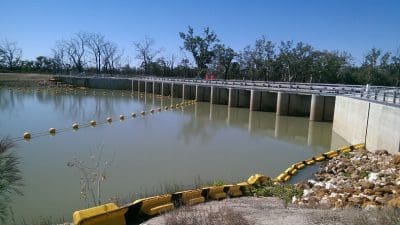The fundamental design of the Murray Darling Plan is good, but the implementation of the plan has a number of shortcomings, writes Dr David Adamson from The Centre for Global Food and Resources.
WELL, the ABC’s Four Corners program (see Grain Central story) has gotten things interesting around the office.
I’m going to start with the easiest thing first, cotton.
Australian agriculture is not restricted by land, it is restricted by water.
The Murray-Darling Basin (MDB) is 1 million square kilometres, about 80 per cent of the MDB is dedicated to agriculture and irrigation is less than 2pc of that area (Australian Bureau of Statistics (ABS), 2008).
The argument that ‘cotton is a thirsty crop’ is a complete red herring.
Cotton is an annual crop that is ideal to plant, as it provides the best $/megalitre from its use, especially in areas where there is little to no water security on an annual basis (i.e. no guarantee of supply so you either have water or you don’t).
If you forbid farmers to plant cotton, they will use the same amount of water producing a crop with a lower $/ML return.
All you do is make the irrigator earn less money.
The real argument is and always will be is how much water should different groups (irrigators, other rural uses, urban supplies, the environment, and other water users) have.
Property rights
Now let’s define water property rights.
Property rights define who can access and use a given resource [read (Quiggin, 1986)].
The ownership of rights allows individuals to make money.
But to be effective the right must be enforced.
 Water entitlements are property rights that provide an irrigator the ability to access water.
Water entitlements are property rights that provide an irrigator the ability to access water.
In the MDB, water entitlements can be divided into three right structures with decreasing reliability, high security, general security and supplementary.
The Barwon-Darling is basically supplementary rights where it’s a use it or lose it mentality, as there is little public storage, hence the large dams.
In many years, the face value of that water entitlement is never delivered.
Common property
The Plan follows the concepts of common property (Ciriacy-Wantrup and Bishop, 1975).
Where to deal with an overall allocation of water in a closed basin (i.e. there are no new water rights to be had), and the externalities caused by that use (e.g. salinity), a quantum of water rights is transferred from private users (i.e. irrigators) to a ‘trustee’ (i.e. Commonwealth Water Entitlement Holder) to manage that ‘environmental’ water in the national interest.
By restricting the volume that irrigators have, and giving water to the environment, the environments health improves and the extra water flowing in the river, improves the quality of asset (i.e. water quality improves via dilution) and everyone benefits from that.
Implementation shortcomings
The fundamental design of the plan is good. The implementation of the plan has a number of shortcomings and that is discussed in the recent submission (here).
What Four Corners discovered is, allegedly, that the monitoring of water extractions and enforcement of property rights has failed in NSW.
Additionally, there may have been collusion and the sharing of public information to a select few.
This creates information asymmetry and subsequently power in the market. The fallout from this allegation will be the interesting part.
The allegation of the volume of water being taken (1.19 gigalitres, need to know if this is a single or multiple years), should have had those responsible for managing the flow scratching their heads as to why water was not reaching expected destinations.
Presently there is insufficient information to know exactly if or how this was followed up.
National interest
The Basin Plan was designed in the national interest, so one would assume that the response should be federal.
But part of this is also derived from the failure of the federal government in not ensuring that monitoring was occurring.
I think the loss of the National Water Commission and the transferring of their data collection to others was an oversight.
………………………
Source: University of Adelaide, The Centre for Global Food and Resources. This post was originally published on Dr Adamson’s blog, where you can read more about his research.




The loss of the National Water Commission and the handing over of their data to the states was more than an “oversight” by a lazy federal government. This has not only affected the reasonable rights of water users to sustainable allocations from the Murray-Darling but has allowed the rights to groundwater from the Great Artesian Basin’s quite useful sub-artesian aquifers to be allocated in unlimited volumes to coal seam gas and other resource industries and irreversibly depressurise these aquifers.
Note that groundwater is “high security water” to be conserved for when rainfall and surface water supplies are minimal.
If the CSG and resource industries wishing to operate in the MDB and GAB want to show that they are sustainable – let them harvest water from areas outside the Basin and GAB at their cost and not at the cost of rural producers. For example, pay for the construction of the Nathan Dam and Pipelines (alreaddy approved by Australian and Queensland Governments and leave a legacy after the gas and coal cease to have any real value to the economy,